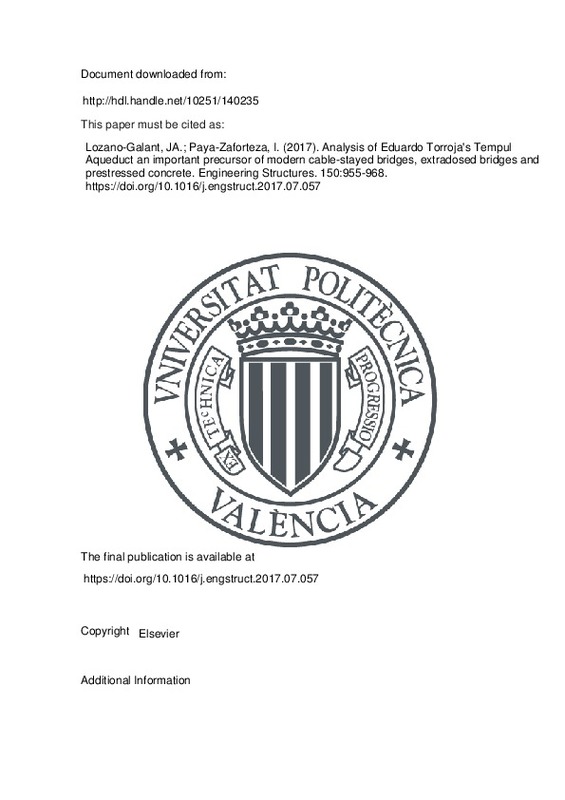JavaScript is disabled for your browser. Some features of this site may not work without it.
Buscar en RiuNet
Listar
Mi cuenta
Estadísticas
Ayuda RiuNet
Admin. UPV
Analysis of Eduardo Torroja's Tempul Aqueduct an important precursor of modern cable-stayed bridges, extradosed bridges and prestressed concrete
Mostrar el registro sencillo del ítem
Ficheros en el ítem
| dc.contributor.author | Lozano-Galant, José Antonio
|
es_ES |
| dc.contributor.author | Paya-Zaforteza, Ignacio
|
es_ES |
| dc.date.accessioned | 2020-04-06T08:57:11Z | |
| dc.date.available | 2020-04-06T08:57:11Z | |
| dc.date.issued | 2017 | es_ES |
| dc.identifier.issn | 0141-0296 | es_ES |
| dc.identifier.uri | http://hdl.handle.net/10251/140235 | |
| dc.description.abstract | [EN] This paper describes a study of the Tempul Aqueduct, one of the first structures designed and built by Eduardo Torroja. At a time when computers did not exist, Torroja's courage and innovation were outstanding. He was in no way constrained by a lack of theoretical knowledge, inadequate materials and the contemporary doubts about cable-stayed structures. In fact, he was able to build one of the world's first prestressed concrete structures, and a precursor to modern cable-stayed and extradosed bridges. This paper briefly reviews the history of the Tempul Aqueduct, gives the results of the analysis of this structure by several Finite Element Models (FEMs), and compares the FEM results to those obtained by Torroja himself. The FEM results confirm the validity of Torroja's conceptual design. The paper also contains a detailed analysis of the influence of the structural system on the behavior of the bridge and the effect of removing the live loads with the aim of providing a better understanding of the context and behavior of the Tempul aqueduct. | es_ES |
| dc.description.sponsorship | Funding for this research has been provided to Mr Lozano-Galant by the Spanish Ministry of Economy, Industry and Competitiveness (Research Project BIA2013-47290-R from FEDER funds). The authors are also grateful to Prof. S. Buonopane of Bucknell University and J.L. Temprado, of COMPOSAN, for their assistance and support. The authors also want to thank the CEHOPU-Archivo Torroja, for all the information and support provided. | es_ES |
| dc.language | Inglés | es_ES |
| dc.publisher | Elsevier | es_ES |
| dc.relation.ispartof | Engineering Structures | es_ES |
| dc.rights | Reserva de todos los derechos | es_ES |
| dc.subject | Tempul aqueduct | es_ES |
| dc.subject | Cable-stayed bridge | es_ES |
| dc.subject | Extradosed bridge | es_ES |
| dc.subject | Prestressed concrete | es_ES |
| dc.subject | Eduardo Torroja | es_ES |
| dc.subject.classification | INGENIERIA DE LA CONSTRUCCION | es_ES |
| dc.title | Analysis of Eduardo Torroja's Tempul Aqueduct an important precursor of modern cable-stayed bridges, extradosed bridges and prestressed concrete | es_ES |
| dc.type | Artículo | es_ES |
| dc.identifier.doi | 10.1016/j.engstruct.2017.07.057 | es_ES |
| dc.relation.projectID | info:eu-repo/grantAgreement/MINECO//BIA2013-47290-R/ES/SISTEMA DE APOYO A LA TOMA DE DECISIONES DURANTE EL CICLO DE VIDA DE LAS INFRAESTRUCTURAS: SMART-INFRASTRUCTURES/ | es_ES |
| dc.rights.accessRights | Abierto | es_ES |
| dc.contributor.affiliation | Universitat Politècnica de València. Departamento de Ingeniería de la Construcción y de Proyectos de Ingeniería Civil - Departament d'Enginyeria de la Construcció i de Projectes d'Enginyeria Civil | es_ES |
| dc.description.bibliographicCitation | Lozano-Galant, JA.; Paya-Zaforteza, I. (2017). Analysis of Eduardo Torroja's Tempul Aqueduct an important precursor of modern cable-stayed bridges, extradosed bridges and prestressed concrete. Engineering Structures. 150:955-968. https://doi.org/10.1016/j.engstruct.2017.07.057 | es_ES |
| dc.description.accrualMethod | S | es_ES |
| dc.relation.publisherversion | https://doi.org/10.1016/j.engstruct.2017.07.057 | es_ES |
| dc.description.upvformatpinicio | 955 | es_ES |
| dc.description.upvformatpfin | 968 | es_ES |
| dc.type.version | info:eu-repo/semantics/publishedVersion | es_ES |
| dc.description.volume | 150 | es_ES |
| dc.relation.pasarela | S\343766 | es_ES |
| dc.contributor.funder | European Regional Development Fund | es_ES |
| dc.contributor.funder | Ministerio de Economía y Competitividad | es_ES |







![[Cerrado]](/themes/UPV/images/candado.png)

